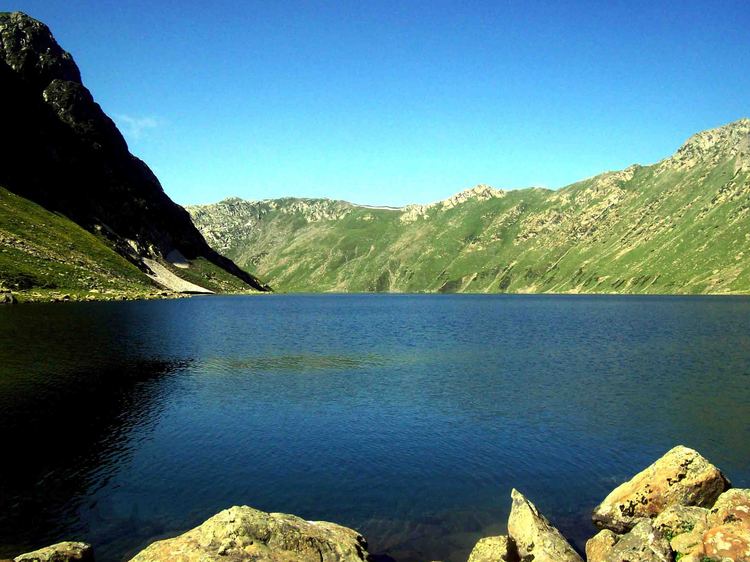Type oligotrophic lake Surface area 2 km (0.77 sq mi) Area 200 ha Width 800 m | Primary inflows Max. length 2 kilometres (1.2 mi) Surface elevation 3,795 m Length 2 km | |
 | ||
Max. width 0.8 kilometres (0.50 mi) | ||
The Tarsar Lake or Tar Sar is an almond-shaped, oligotrophic alpine lake situated in the Kashmir Valley, specifically in Aru, Anantnag district, Jammu and Kashmir, India.
Contents
Map of Tarsar Lake, 191202
Geography
The Tarsar Lake is dominated by the peaks of the Kolahoi mountain some 20 km to the east. The lake is separated by a mountain with a minimum peak elevation of 4,000 metres (13,000 ft) from another lake of the same nature known as Marsar Lake, which is in the vicinity of Dachigam National Park. Together these two lakes are referred to as the twin sisters. The 16th-century Kashmiri ruler Yusuf Shah Chak mentioned the twin lakes in his poetry, writing to his beloved:
When I remember the two tresses of the comely beloved,
Tears begin to flow from my eyes like streams from Tarsar and Marsar.
The Tarsar Lake is drained by an outlet stream which falls into the Lidder River at Lidderwat, 15 km to the east. Being the nearest seasonal settlement, Lidderwat is located on the trek route to the lake from Aru, Pahalgam. The Marsar Lake on the other hand drains out and flows in the opposite direction of the Tarsar Lake.
Flora and fauna
During the winter, the Tarsar Lake freezes and is covered by heavy snow; it has floating ice even in the summer. The basin of the lake is surrounded by a sheet of alpine flowers. The geum, blue poppy, potentilla and gentian are relatively common. Hedysarum flowers are found in late spring throughout the area around the lake.
During summer there are breeding colonies of migratory birds, including bar-headed geese, lammergeyers, high-flying choughs, Himalayan golden eagles, cinnamon sparrows and black bulbuls. The basin of Tarsar and the adjoining Dachigam National Park constitute one of the most important habitats of the Kashmir stag (hangul), ibex, musk deer, snow leopard, Himalayan brown bear and in the higher reaches, the golden marmot.
Access
The Tarsar Lake is accessible only during the summer; during the winter, the treks are closed because of the heavy snowfall. It can be reached from Srinagar, via a 102 km motorable road which leads through Anantnag and Pahalgam to the Aru trekking camp. The alpine meadow of Lidderwat lies at the halfway point of the two-day trek to the lake. An alternate route leads through Ganderbal and a trekking starting point at Sumbal in the Sind Valley. Due to the steepness of the trek, it is preferable to approach the lake by the Aru-Lidderwat trek and return via the Sumbal-Sind Valley trek. Another accessible route to Tarsar and Marsar is a Place called Nage-Baren via Tral.
